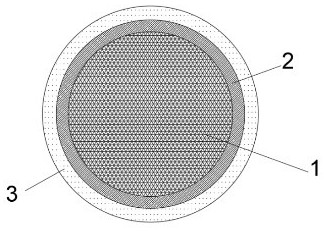Customized medical porous titanium-magnesium composite material 3D printed shoulder joint humeral head
A composite material and 3D printing technology, applied in the field of medical implants, can solve the problems of falling off, shortening the service life, and poor fixing effect.
- Summary
- Abstract
- Description
- Claims
- Application Information
AI Technical Summary
Problems solved by technology
Method used
Image
Examples
Embodiment Construction
[0027] Step 1: Scan the skeletal tissue structure of the part of the human body that needs to be replaced with a CT scanning device, and establish a three-dimensional structural data model of the skeletal tissue structure of the part.
[0028] The second step: molar ratio of metal Ti powder, Mg particles, Si particles, Ca particles, Cu particles, Ag particles, Ni powder and Mo powder: (25-45): (15-30): (20-35 ): (5-10): (3-6): (5-15): (3-8): (0.1-0.5) After uniform mixing and preparation, the mixture is subjected to high-energy ball milling, Make the maximum spherical diameter not exceed 100nm to obtain ultrafine powder.
[0029] Add the modificator to the powder and preheat it by irradiation, continue to stir the mixed material within 30 minutes, and at the same time heat the temperature of the raw material to 150°C at a uniform speed, and keep it warm for later use. The stirring operation adopts magnetic stirring, and the preheating heat source is a radiation heat source. ...
PUM
| Property | Measurement | Unit |
|---|---|---|
| size | aaaaa | aaaaa |
Abstract
Description
Claims
Application Information
 Login to View More
Login to View More - R&D
- Intellectual Property
- Life Sciences
- Materials
- Tech Scout
- Unparalleled Data Quality
- Higher Quality Content
- 60% Fewer Hallucinations
Browse by: Latest US Patents, China's latest patents, Technical Efficacy Thesaurus, Application Domain, Technology Topic, Popular Technical Reports.
© 2025 PatSnap. All rights reserved.Legal|Privacy policy|Modern Slavery Act Transparency Statement|Sitemap|About US| Contact US: help@patsnap.com

